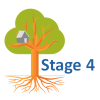This webinar will present the steps to apply a type of latent class analysis on longitudinal data commonly known as growth mixture model (GMM). This family of models is a natural extension of  the latent variable model. GMM combines longitudinal data analysis and Latent Class Analysis to extract the probabilities of each case to belong to latent trajectories with different model parameters. A brief (not exhaustive) list of steps to prepare, analyze and interpret GMM will be presented. A published case will be described to exemplify an application of GMM and its complexity.
the latent variable model. GMM combines longitudinal data analysis and Latent Class Analysis to extract the probabilities of each case to belong to latent trajectories with different model parameters. A brief (not exhaustive) list of steps to prepare, analyze and interpret GMM will be presented. A published case will be described to exemplify an application of GMM and its complexity.
Finally, an alternative approach to GMM will be presented where the longitudinal model approach is linear mixed effects (also known as hierarchical linear model or multilevel modeling). The idea is the same as in GMM using growth curve modeling, mainly that the latent class membership specifies specific unobserved trajectories. These models are equivalent to GMM and are sometimes referred to heterogeneous linear mixed effects, underlining the idea that the sample may not belong to one single homogeneous population, but potentially to a mixture of distributions.
Note: This training is an exclusive benefit to members of the Statistically Speaking Membership Program and part of the Stat’s Amore Trainings Series. Each Stat’s Amore Training is approximately 90 minutes long.
(more…)
Correspondence analysis is a powerful exploratory multivariate technique for categorical variables with many levels. It is a data analysis tool that characterizes associations between levels of two or more categorical variables using graphical representations of the information in a contingency table. It is particularly useful when categorical variables have many levels.
more categorical variables using graphical representations of the information in a contingency table. It is particularly useful when categorical variables have many levels.
This presentation will give a brief introduction and overview of the use of correspondence analysis, including a review of chi square analysis, and examples interpreting both simple and multiple correspondence plots.
Note: This training is an exclusive benefit to members of the Statistically Speaking Membership Program and part of the Stat’s Amore Trainings Series. Each Stat’s Amore Training is approximately 90 minutes long.
(more…)
Smoothing can assist data analysis by highlighting important trends and revealing long term movements in time series that otherwise can be hard to see.
Many data smoothing techniques have been developed, each of which may be useful for particular kinds of data and in specific applications. David will give an introductory overview of the most common smoothing methods, and will show examples of their use. He will cover moving averages, exponential smoothing, the Kalman Filter, low-pass filters, high pass filters, LOWESS and smoothing splines.
This presentation is pitched towards those who may use smoothing techniques during the course of their analytic work, but who have little familiarity with the techniques themselves. David will avoid the underpinning mathematical and statistical methods, but instead will focus on providing a clear understanding of what each technique is about.
Note: This training is an exclusive benefit to members of the Statistically Speaking Membership Program and part of the Stat’s Amore Trainings Series. Each Stat’s Amore Training is approximately 90 minutes long.
(more…)
 Latent Class Analysis is a method for finding and measuring unobserved latent subgroups in a population based on responses to a set of observed categorical variables.
Latent Class Analysis is a method for finding and measuring unobserved latent subgroups in a population based on responses to a set of observed categorical variables.
This webinar will present an overview and an example of how latent class analysis works to find subgroups, how to interpret the output, the steps involved in running it. We will discuss extensions and uses of the latent classes in other analyses and similarities and differences with related techniques.
Note: This training is an exclusive benefit to members of the Statistically Speaking Membership Program and part of the Stat’s Amore Trainings Series. Each Stat’s Amore Training is approximately 90 minutes long.
(more…)
Whenever we run an analysis of variance or run a regression one of the first things we do is look at the p-value of our predictor variables to determine whether
they are statistically significant. When the variable is statistically significant, did you ever stop and ask yourself how significant it is? (more…)
P-values are the fundamental tools used in most inferential data analyses (more…)
(more…)
 the latent variable model. GMM combines longitudinal data analysis and Latent Class Analysis to extract the probabilities of each case to belong to latent trajectories with different model parameters. A brief (not exhaustive) list of steps to prepare, analyze and interpret GMM will be presented. A published case will be described to exemplify an application of GMM and its complexity.
the latent variable model. GMM combines longitudinal data analysis and Latent Class Analysis to extract the probabilities of each case to belong to latent trajectories with different model parameters. A brief (not exhaustive) list of steps to prepare, analyze and interpret GMM will be presented. A published case will be described to exemplify an application of GMM and its complexity.

